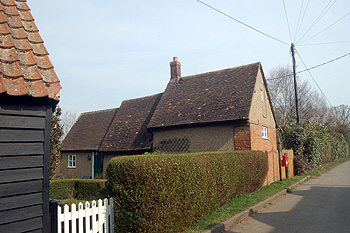
258 Old Harrowden Road March 2011
258 Old Harrowden Road was listed by the former Department of Environment in May 1984 as Grade II, of special interest. The department dated the property to the 18th century. It is timber framed with red brick facing to the south gable end and pebble-dashed render elsewhere, having a clay tiled roof. The southern part of the house is a single storey with attics, the northern part just a single storey.
We are fortunate that three surveys of the parish of Cardington from the late 18th century survive. The first of these was undertaken in 1782 by James Lilburne. He was the parish schoolmaster and later agent for Samuel Whitbread, who owned large estates in the parish and also the sole Enclosure Commissioner for the parish. He produced a list of all the inhabitants of the parish arranged by house and hamlet [P38/28/1]. This was published, with extensive analysis by County Archaeologist David Baker in 1973 as Bedfordshire Historical Record Society Volume 52.
Since publication a second list has been found [P38/28/2]. It carries revisions up to the year 1789. Sadly neither of these surveys includes a map. Finally, in 1794 Lilburne produced another survey [W2/6/1-3] and this one had a map with a key showing where each house was. One can use this to plot the houses of the previous surveys and this work was carried out by John Wood of Bedfordshire County Council’s Conservation Section in October 1982 [CRT130Cardington29].
The 1782 survey [P38/28/1/2] states that John Tyson was in residence. He was a 25 year old labourer who had been born at Turvey. His wife was 24 year old Mary, née Finch, who had been born at Bedford and made lace. They had three children who were all taught to sing: William, aged 4, who was schooled at the expense of John Howard; John, aged 3, also schooled at John Howard’s expense and 1 year old Thomas. A fourth child, James, was born on 8ths September 1785. The parents were willing for themselves and their children to be inoculated against smallpox if others in the parish were also willing. By 1794 [W2/6/1-3] John Tyson was still in residence.
Tithes were, originally, a tenth of one’s household produce, usually an arable crop such as wheat or barley but possibly livestock or manufactured produce such as shoes, given to support the local priest. They were divided into great and little tithes. Great tithes consisted of grain or large animals such as cattle. Little tithes were fruit, vegetables or other small crops and smaller farm animals such as poultry. By the 19th century this archaic practice had long been replaced by monetary tithes. The Tithe Commutation Act of 1836 finally made it compulsory to replace these archaic tithes with monetary payments. The payment was calculated on the seven year average of prices for the particular commodity derived from the land in question and was worked out by the parties involved – parson, landowners or tenants if the land was not owner-occupied. The parish of Cardington, including Harrowden, was assessed for tithes in 1840 [AT9/1]. At that date 258 Old Harrowden Road was owned by the Whitbread Estate and occupied by “Tompkins and others”, whose homestead and pasture comprised 3 roods, 29 poles. They paid 1/7 annually to the vicar and 4/3 shillings to the improprietor (the holder of the advowson).
The Rating and Valuation Act 1925 specified that every building and piece of land in the country was to be assessed to determine its rateable value. Eastcotts, like most of the county, was assessed in 1927 and the valuer visiting 258 Old Harrowden Road [DV1/C280/62] found it owned by the Whitbread Estate and inhabited by W. Addington who paid rent of £4 per annum for a kitchen, ground floor bedroom and one bedroom in the attics. There was also a weather-boarded and tiled washhouse outside. It was: “well kept by Estate. Stands low”.